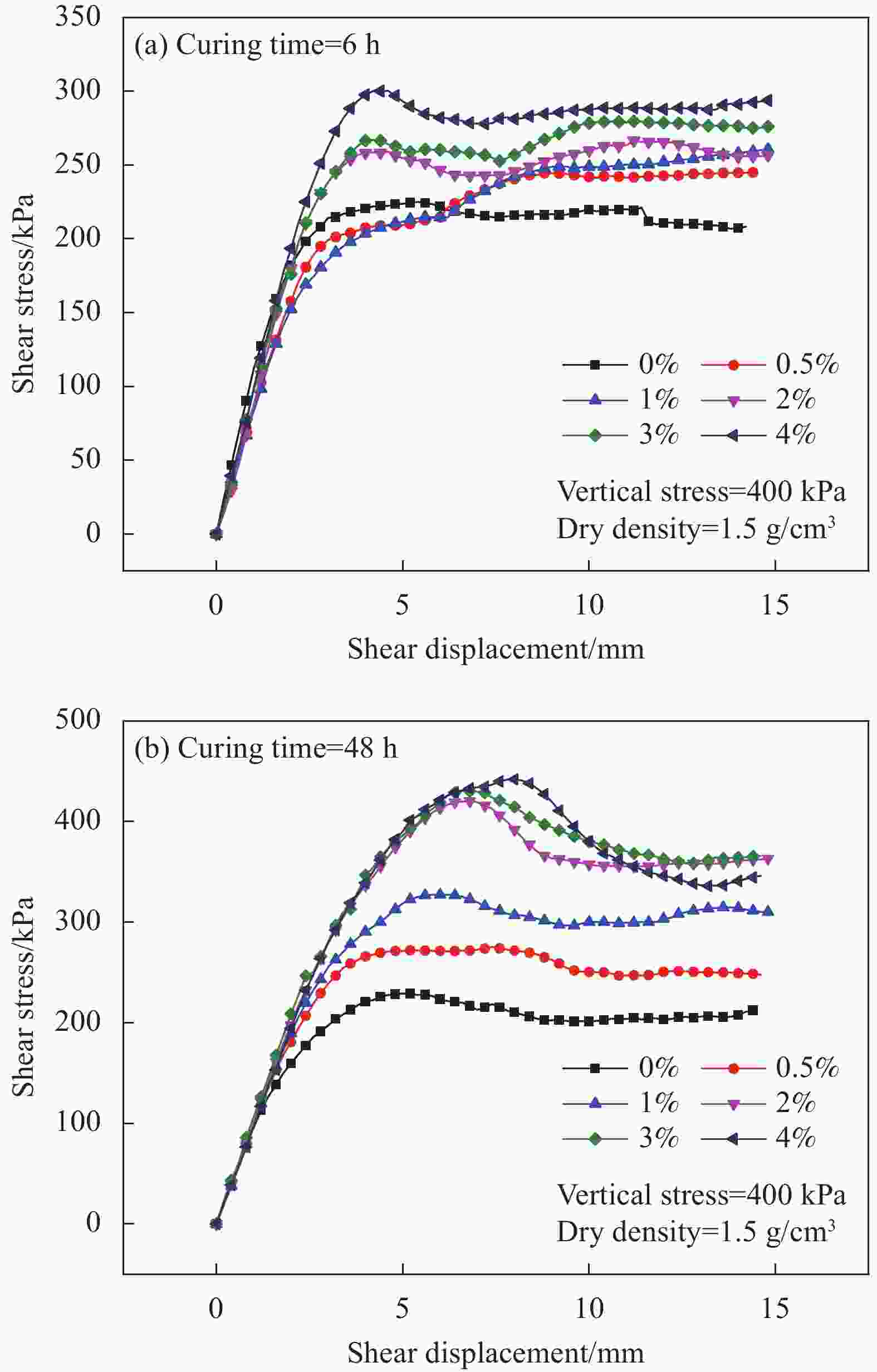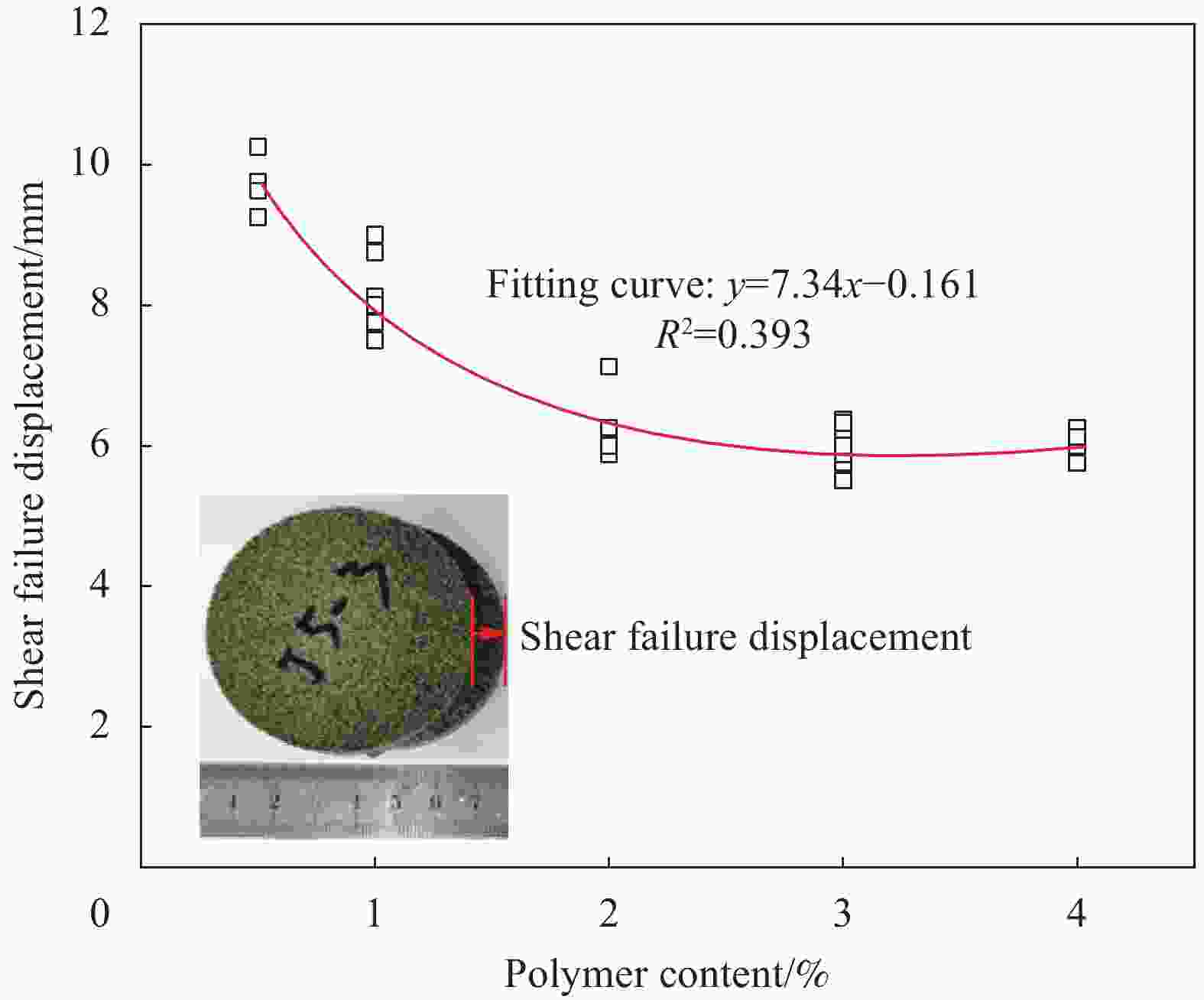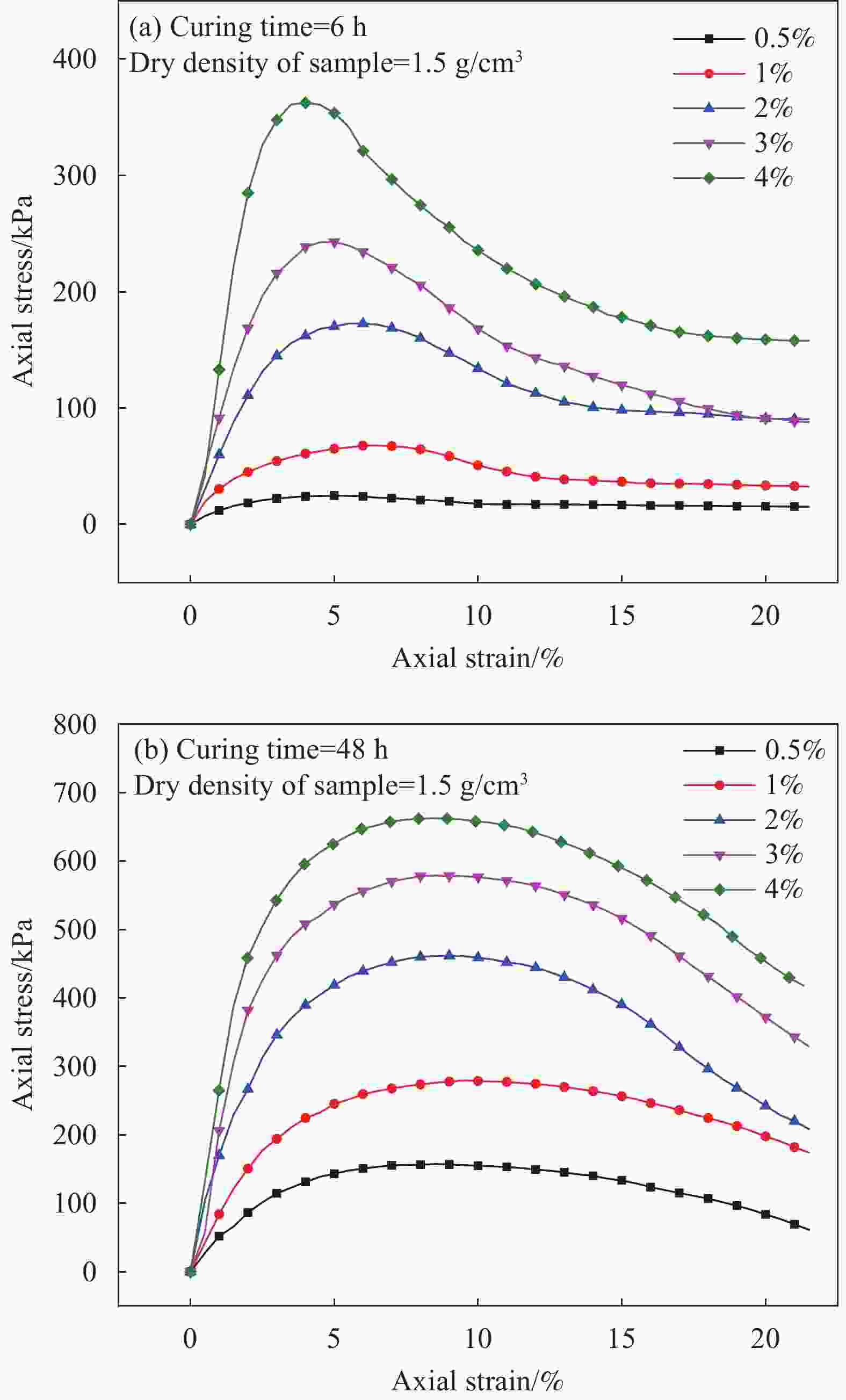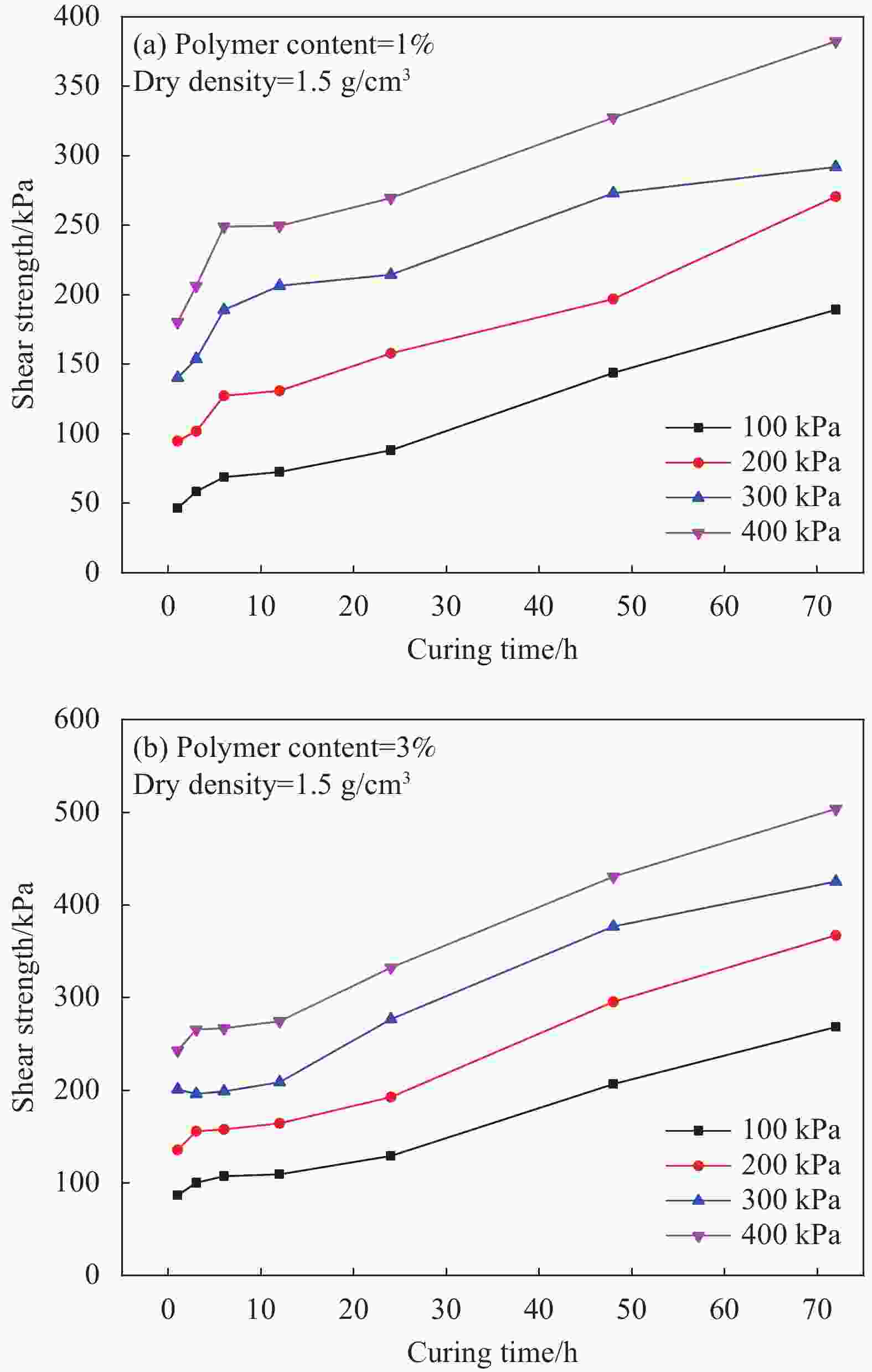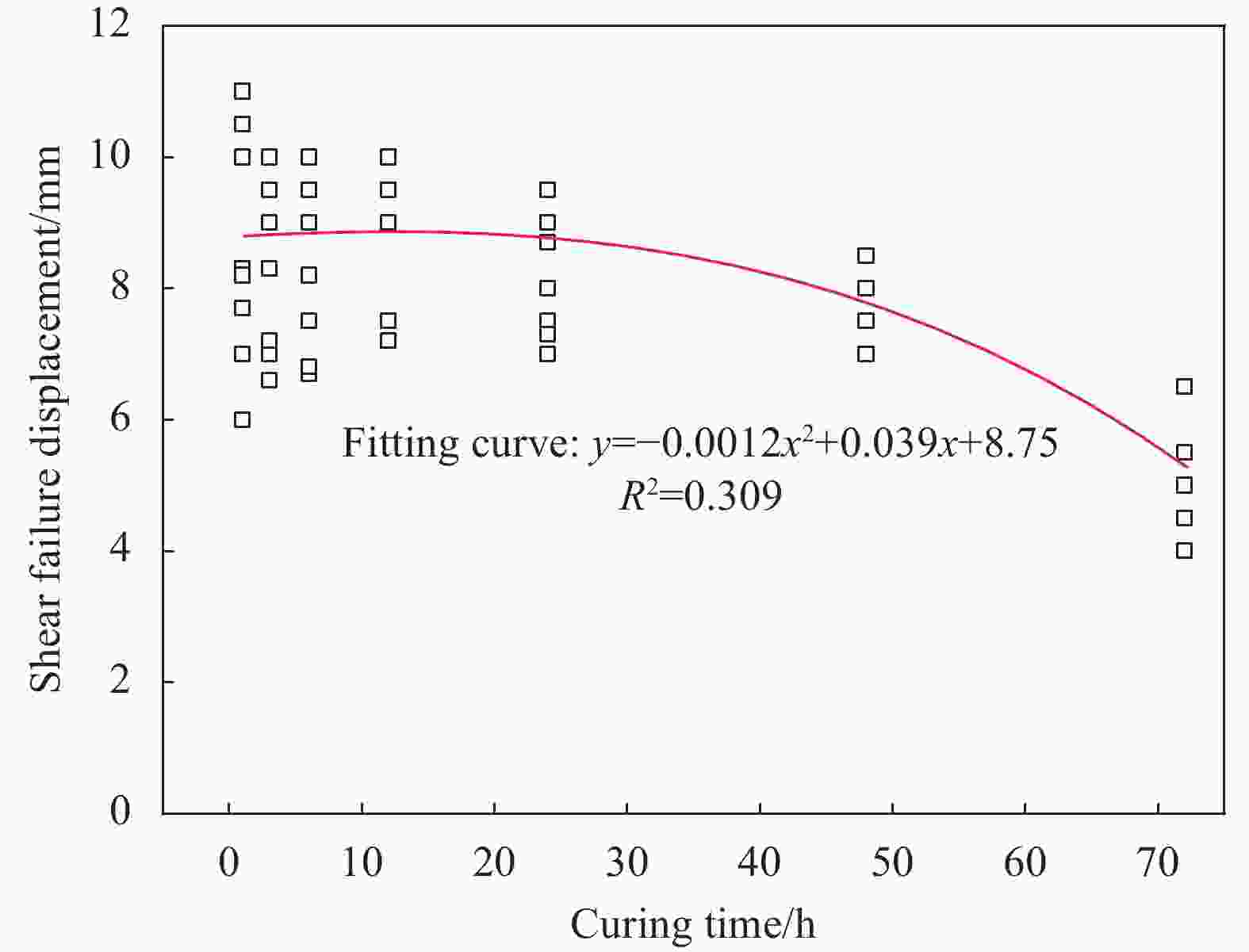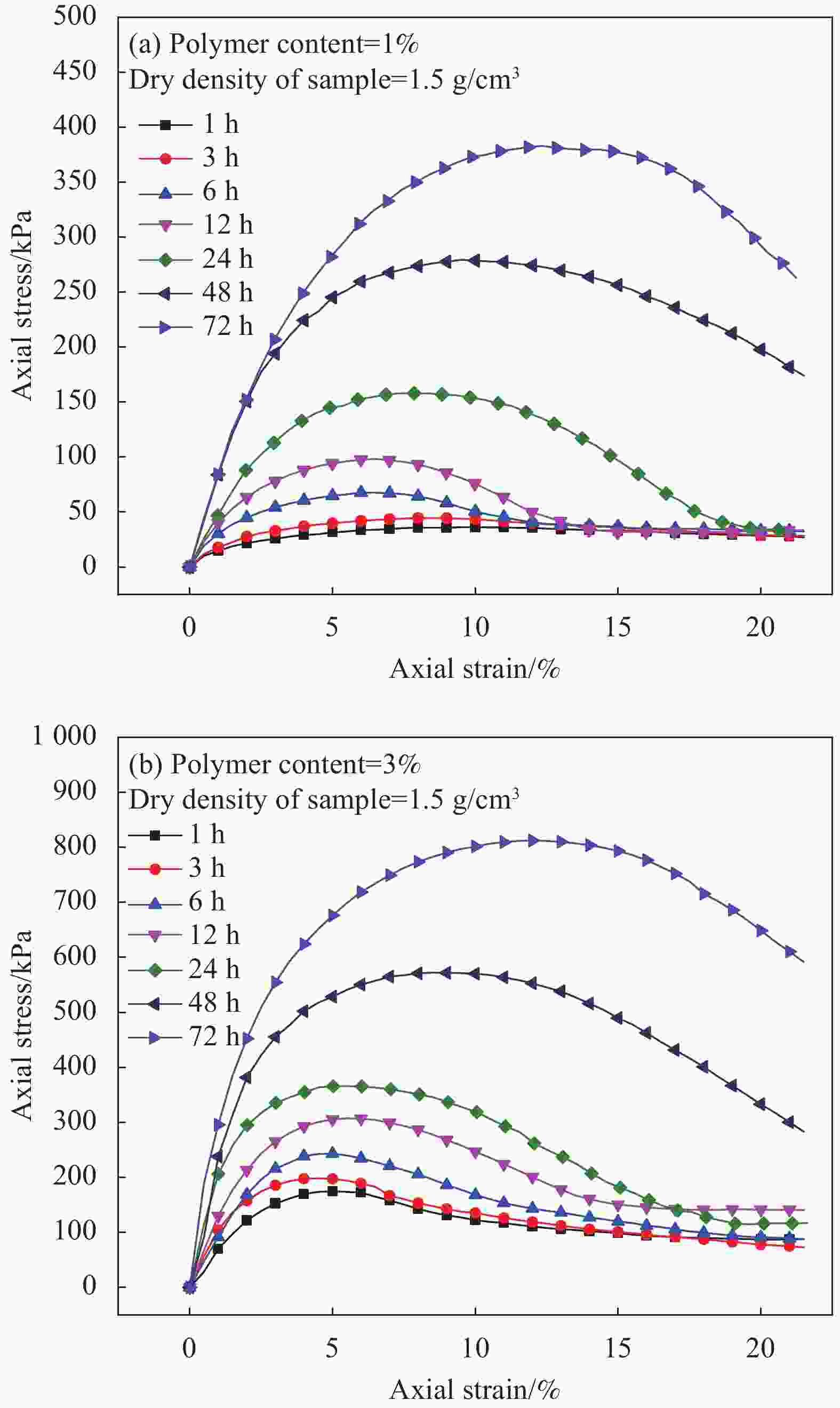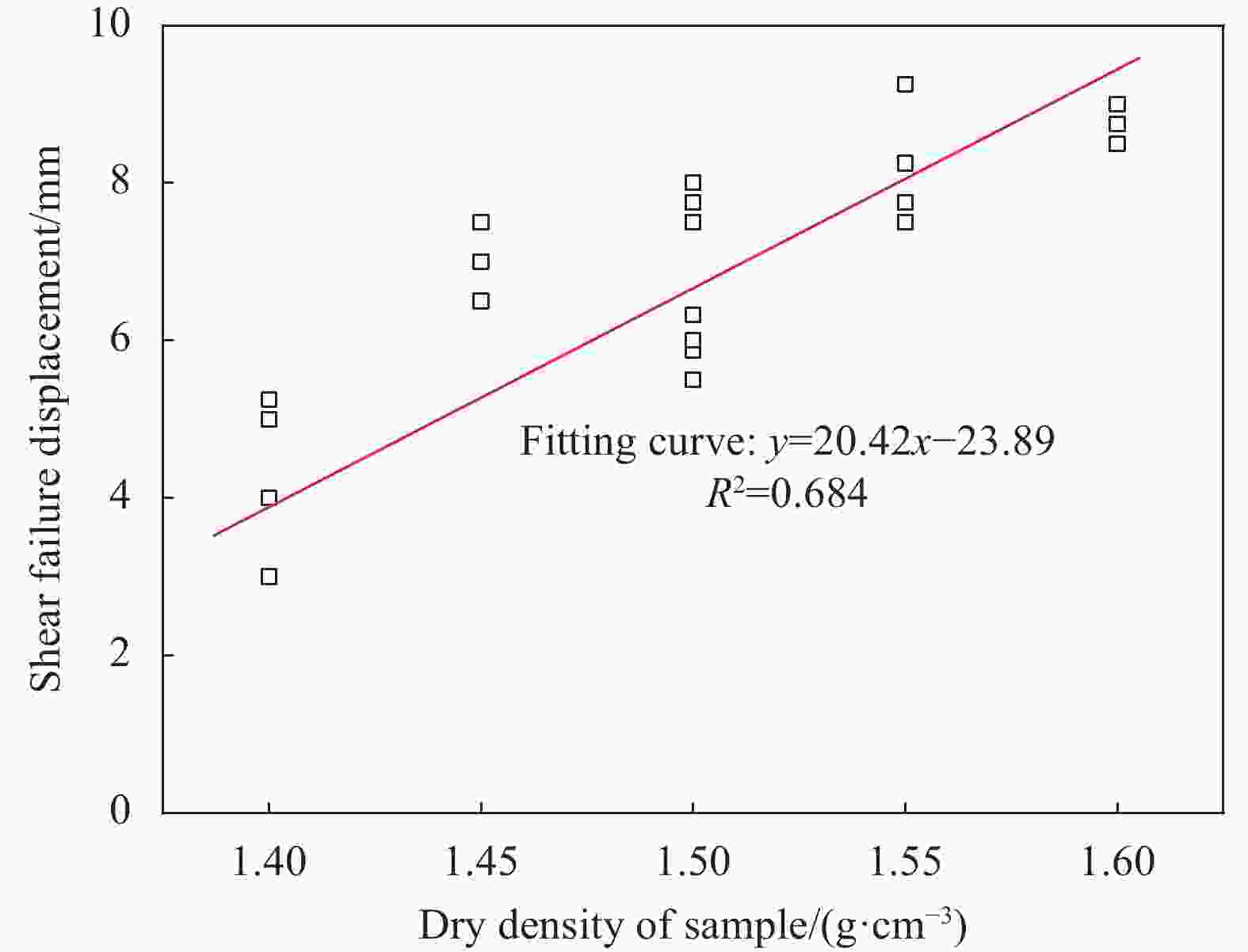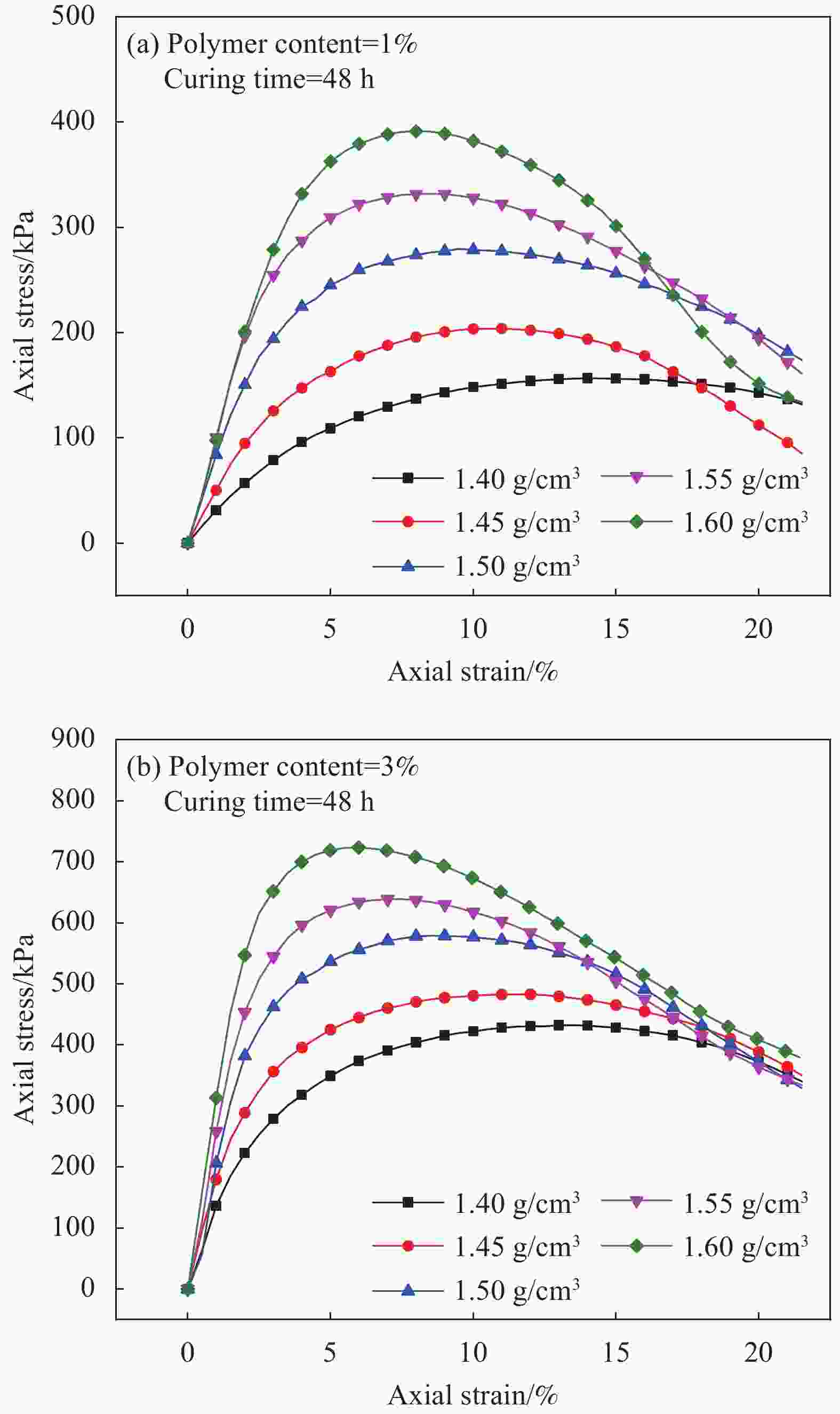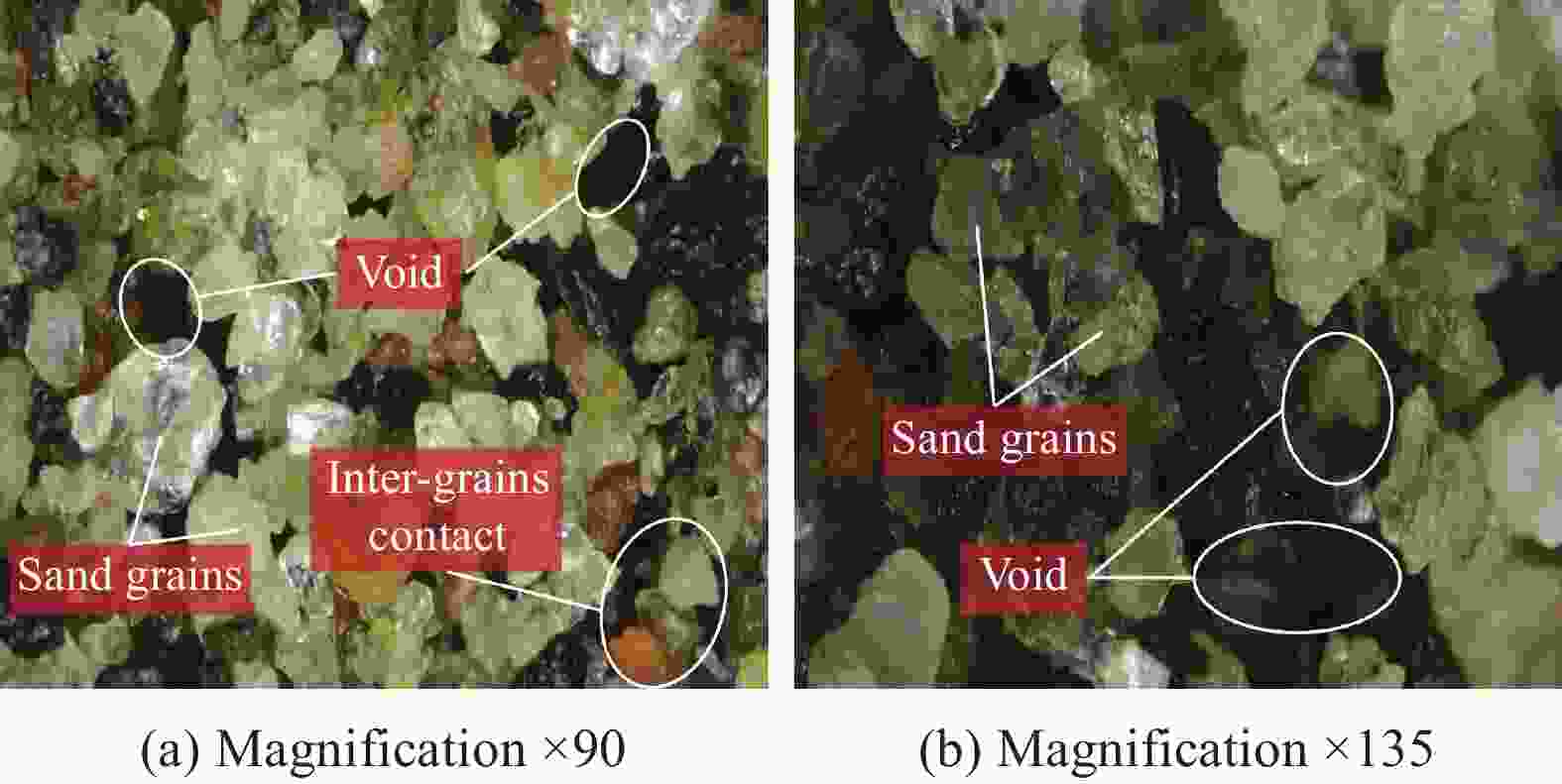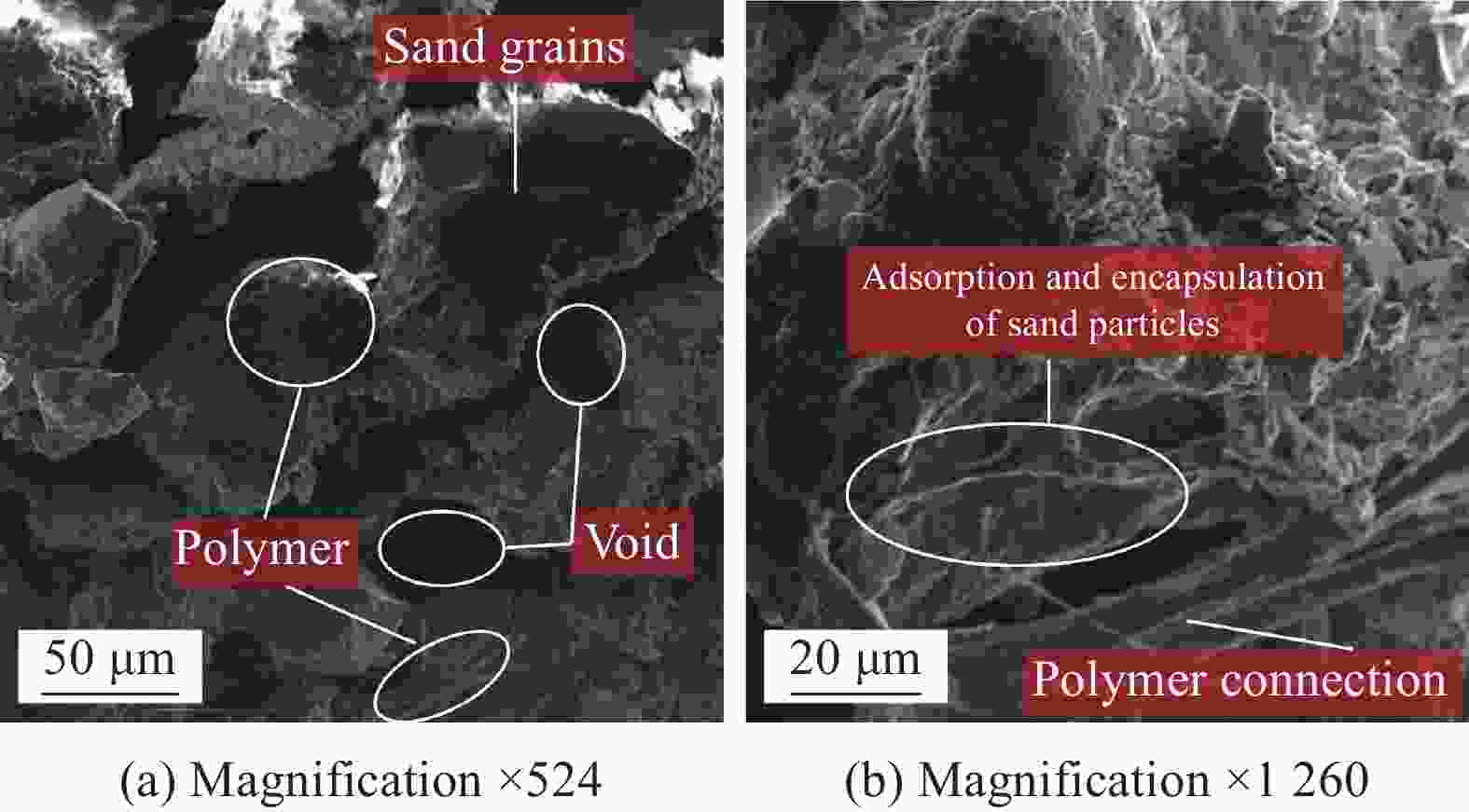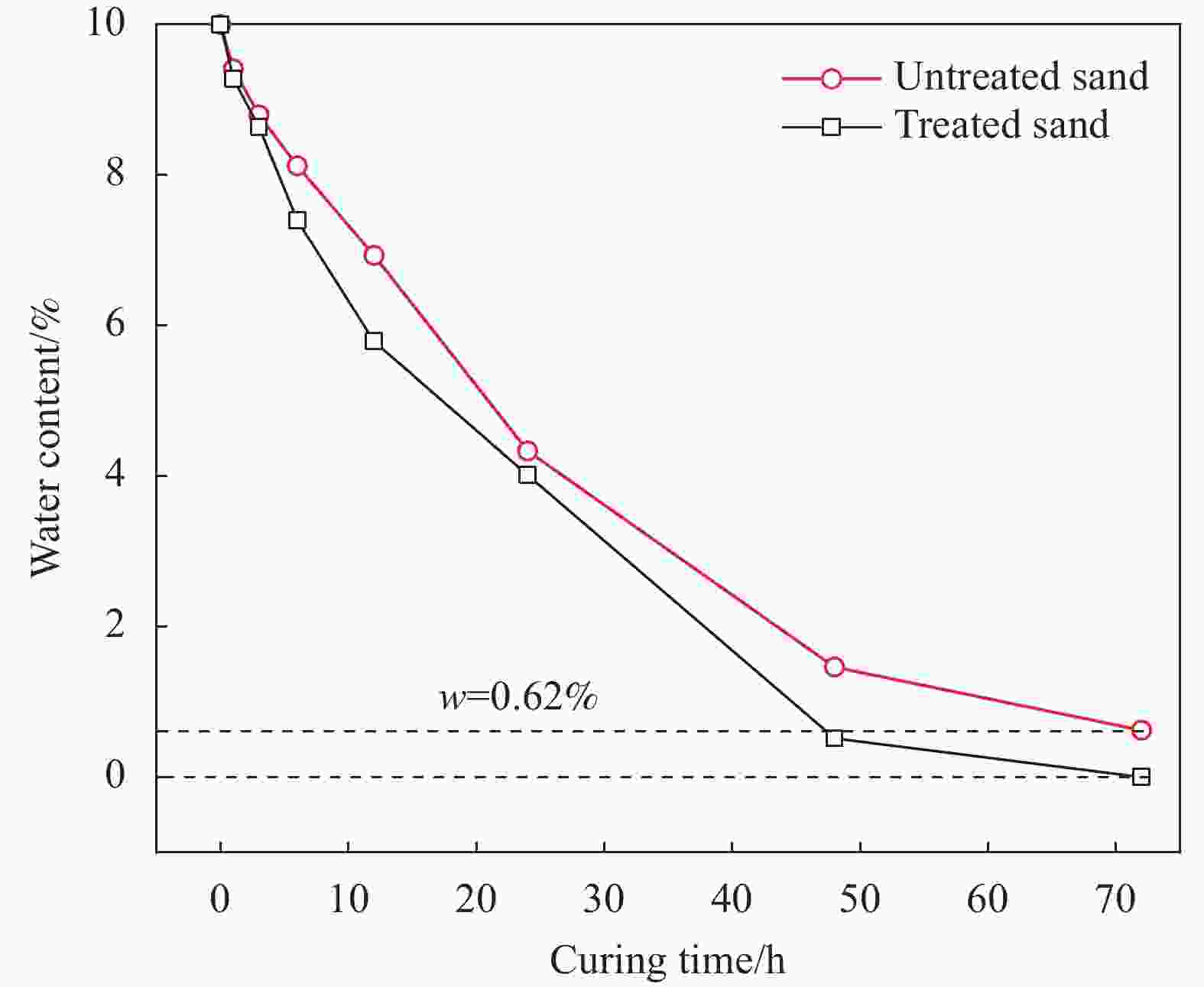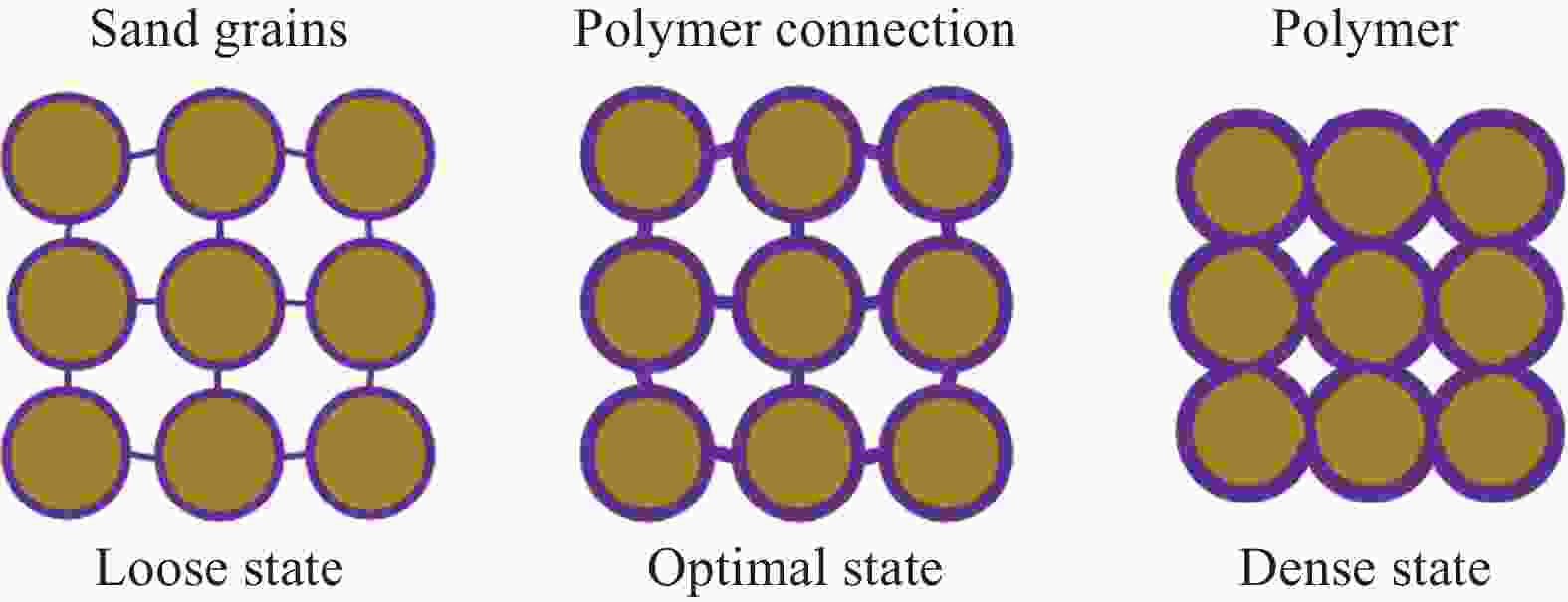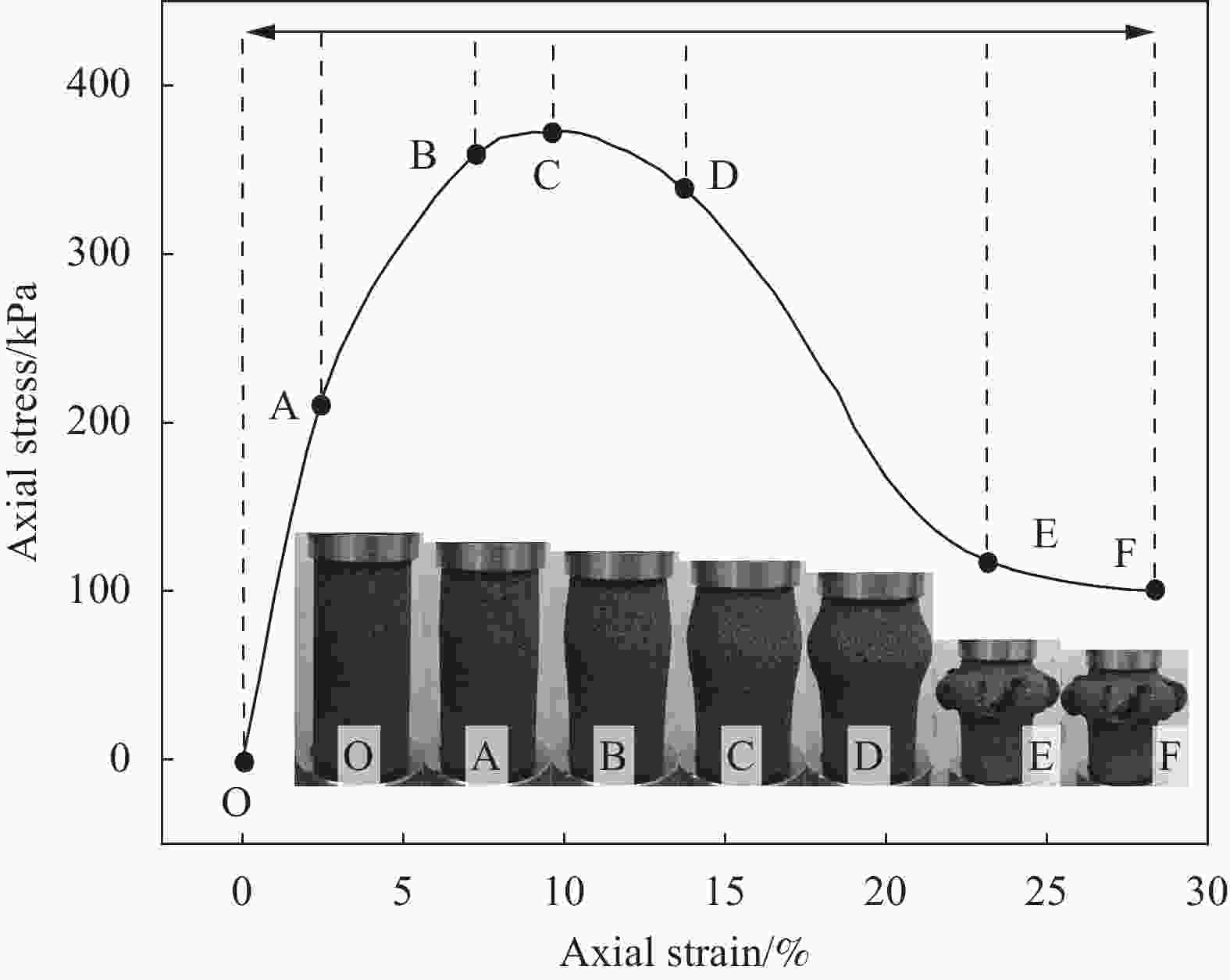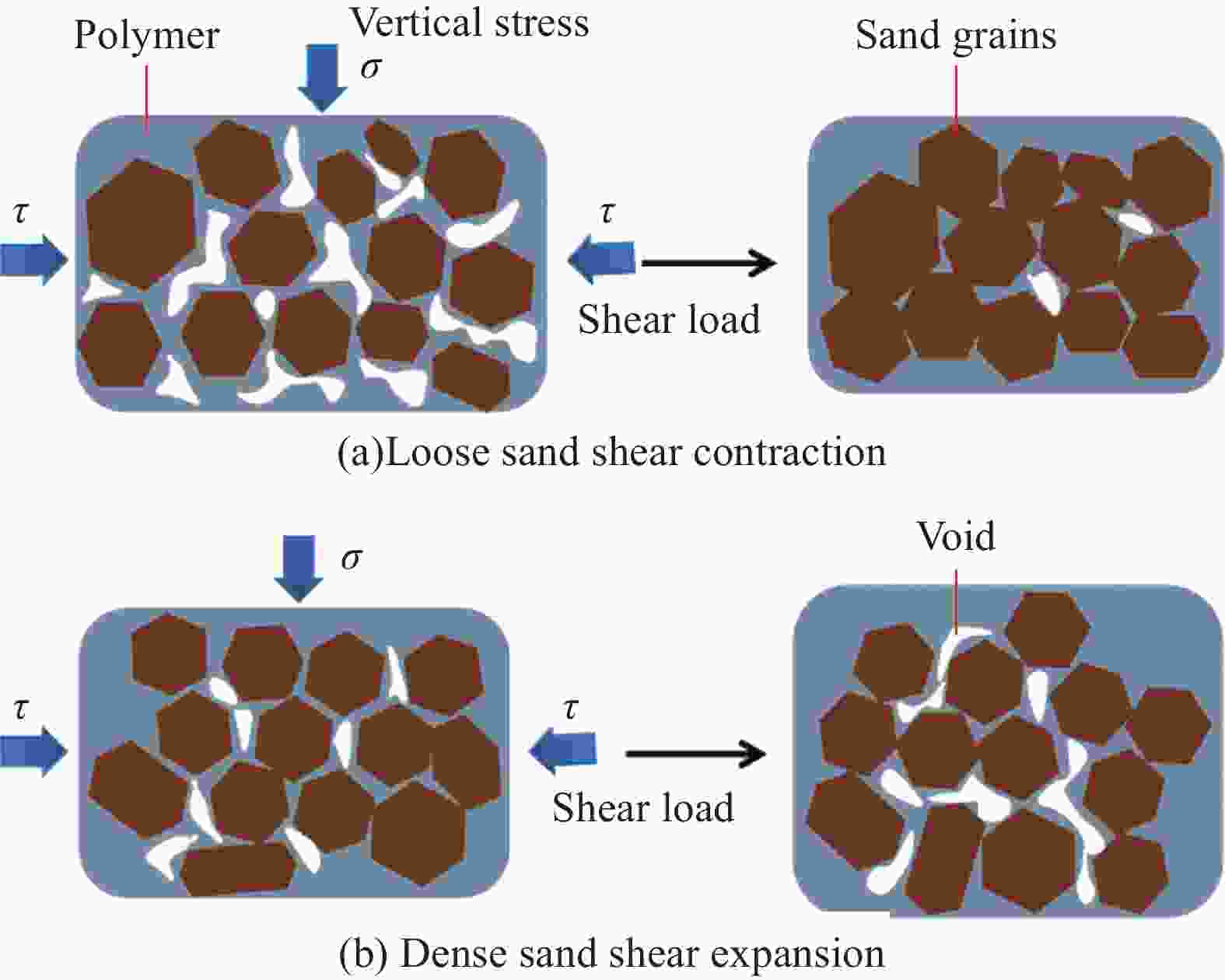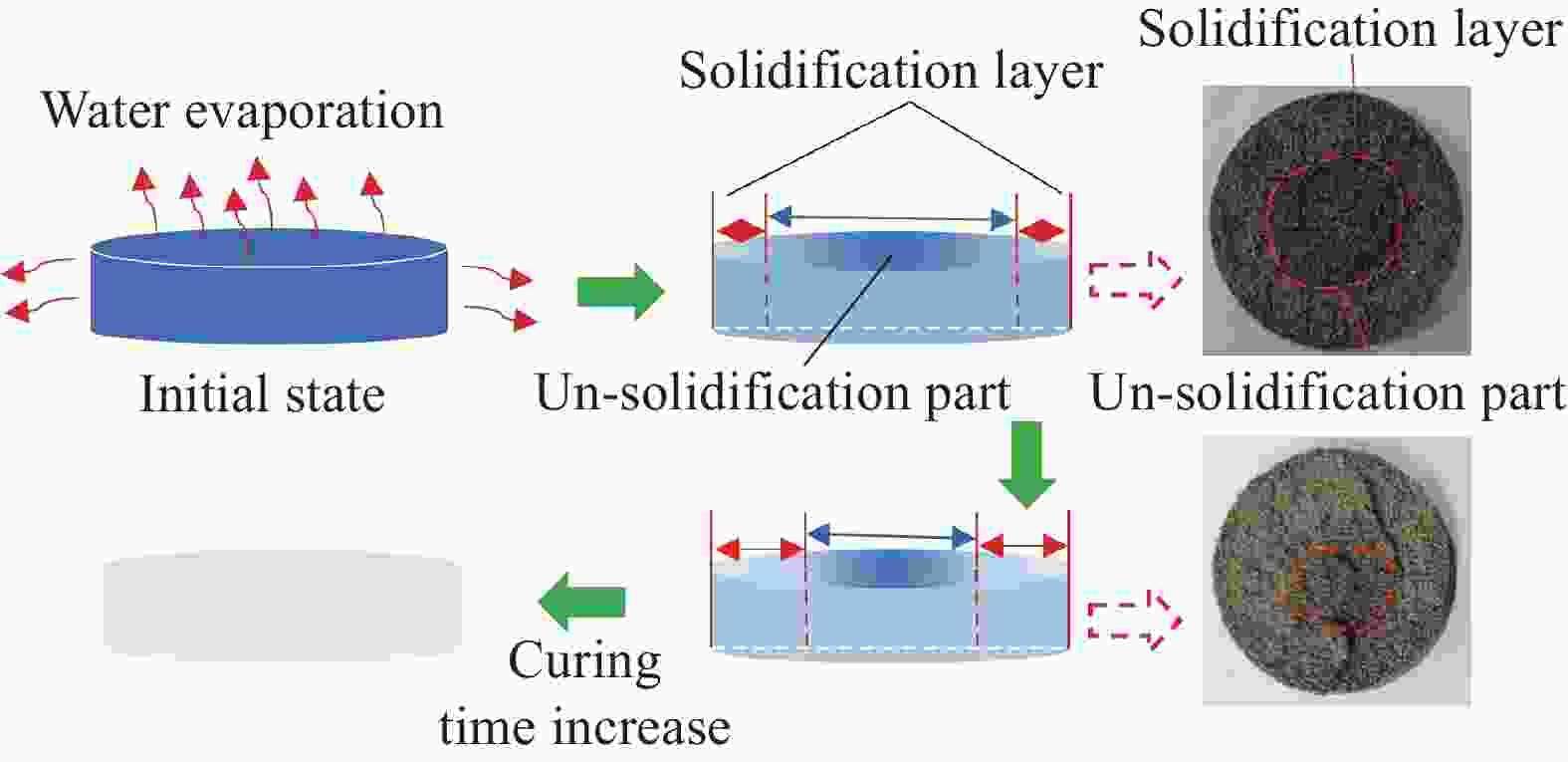Experimental study on strength and deformation characteristics of polymers treated sand
-
摘要: 基于高聚物加固砂土展开抗剪和抗压试验,分析了高聚物掺量、养护时间和干密度对加固砂土强度和变形特征的影响,并阐明其相关性,最后结合SEM图像揭示了高聚物加固砂土的破坏机理。结果表明:(1)三个研究变量对加固砂土抗压和抗剪强度有显著促进作用,其中高聚物含量和养护时间对抗剪强度的影响主要体现在黏聚力上,并且强度与养护时间强正相关,与高聚物含量和干密度中等正相关,可用对数函数(或线性函数)表示其关系;(2)三个研究变量增加时,试样剪切特征由剪切硬化型转变为剪切软化型、破坏位移逐渐减小(干密度减小时),轴向应力-应变曲线表现明显的峰后缓和现象并产生明显的变化,破坏模式以鼓胀并伴有裂缝为主,形态由E型逐渐变为G型(干密度减小时);(3)加固砂土变形特征与养护时间强正相关,与干密度中等负相关,而与高聚物含量相关性不显著,峰值应变与三个研究变量呈多项式(或线性)关系;(4)对于高聚物加固砂土,最佳掺量为约2%,养护24h及以上时效果显著;(5)高聚物通过吸附、黏结和填充作用在砂粒间形成有效稳定的三维网状膜结构,从而改良砂土微观结构,高聚物在荷载下的变化类型占比决定了加固砂土的变形能力和破坏模式,而这与高聚物掺量、养护时间和干密度密切相关。Abstract: Polymer has broad application prospects in soil stabilization. However, there is currently little research on the strength and deformation characteristics of polymer treated soil, as well as the degree of influence of different influencing factors. In this work, a series of unconfined compression strength and shear strength tests were performed on a water-soluble polymer treated sand, and subsequently, the effects of polymer content, curing time and dry density on the strength and deformation characteristics of the treated sand were analyzed. Also, the degree of influence of the three research variables was elucidated using correlation analysis. And finally, the related mechanism of treated sand was revealed using electron microscopy scanning (SEM) observations. The results show that, (1) The three studied variables significantly enhance the unconfined compression strength and shear strength, and the influence of polymer content and curing time on shear strength was mainly reflected in the cohesion. The strength of polymer treated sand is significantly and positively correlated with curing time, and moderately and positively correlated with polymer content and dry density. In addition, these relationships can be represented by a logarithmic function or linear function. (2) As the polymer content, curing time and dry density increase, the shear characteristics of treated sand change from shear hardening type to shear softening type, and the shear failure displacement of treated sand decreases gradually (as dry densities decreases). Also, its axial stress-strain curve shows obvious post-peak easing phenomenon and then produces obvious changes, and the compression failure pattern is dominated by bulging and accompanied by cracks, what’s more, this pattern gradually changes from E-type to G-type (as dry densities decreases). (3) The deformation capacity of treated sand is strongly and positively correlated with curing time, moderately and positively correlated with dry density, while the correlation with polymer content is not significant. Additionally, the peak strain has a polynomial (or linear) relationship with three studied variables. (4) For this polymer treated sand, the optimum mixing content is about 2%, and when the curing time reaches 24h and above, it shows a better treatment effect. (5) The polymer forms an effective and stable three-dimensional membrane structure in the sand particles by adsorption, bonding and filling effects, and thus effectively improves the microstructure of sand. The proportion of changes in the types of polymers under load determines the strength, deformation capacity, and failure mode of treated sand, which is closely related to polymer content, curing time and dry density.
-
Key words:
- polymer /
- sand /
- strength properties /
- deformation characteristics /
- correlation analysis /
- micro-mechanism
-
表 1 砂土基本物理参数
Table 1. Basic physical parameters of sand
Type Specific
gravityMaximum dry density/(g·cm−3) Minimum dry density/(g·cm−3) d10/
mmd30/
mmd50/
mmd60/
mmNonuniform
coefficient CuCurvature
coefficient CcClassifications Sand 2.65 1.69 1.33 0.12 0.23 0.31 0.36 3.00 1.23 Graded poor sand Notes: d10, d30, d50, d60 refer to the grain size at which 10%, 30%, 50% and 60% of the total mass of the sample is contained, respectively, on the distribution curve. 表 2 高聚物基本物理参数
Table 2. Basic physical parameters of used polymer
Appearance Gs η/(MPa∙s) Ws /% pH Cw Light yellow
transparent emulsion1.15 700-800 ≥88 7 ≥40 Notes: Gs η, Ws and Cw are the specific gravity, viscosity, sloid content and water holding capacity of the used polymer. 表 3 不同高聚物含量下加固砂土抗剪强度参数(c:kPa,φ:°)
Table 3. Shear strength index of improved sandy soils with different polymer contents (c: kPa, φ: °)
T/h ρd/(g·cm−3) Wp /% 0 0.5 1 2 3 4 c φ c φ c φ c φ c φ c φ 6 1.5 0.79 29.67 2.79 30.85 7.79 31.09 19.91 30.83 52.69 27.49 71.65 29.95 48 1.5 2.03 29.41 31.17 30.63 78.53 32.08 127.03 36.43 139.25 36.98 183.52 33.27 Notes: T is the curing time, ρd is the dry density of sample and Wp refers to the polymer content. 表 4 不同高聚物含量下加固砂土抗压强度(kPa)
Table 4. Unconfined compressive strength of polymer treated sand with different polymer contents (kPa)
T/h ρd/(g·cm−3) Wp /% 0.5 1 2 3 4 6 1.5 24.40 67.03 172.31 242.90 360.98 48 1.5 159.21 301.86 458.40 581.37 662.58 表 5 不同养护时间下高聚物加固砂土抗剪强度参数(c:kPa,φ:°)
Table 5. Shear strength parameters of polymer treated sand cured at different times (c: kPa, φ: °)
Wp /% ρd/(g·cm−3) T/h 1 3 6 12 24 48 72 c φ c φ c φ c φ c φ c φ c φ 1 1.5 3.43 24.12 6.15 26.36 7.79 31.09 13.09 31.26 32.20 31.01 78.53 32.08 133.27 31.00 3 1.5 33.18 28.10 45.19 28.24 52.69 27.49 54.27 28.37 59.47 34.74 139.25 36.98 200.19 37.39 表 6 不同干密度下高聚物加固砂土抗剪强度参数(c:kPa,φ:°)
Table 6. Shear strength parameter of polymer treated sand under different dry densities (c: kPa, φ: °)
T/h Wp /% ρd/(g·cm−3) 1.4 1.45 1.5 1.55 1.6 c φ c φ c φ c φ c φ 48 1 62.10 28.12 68.73 28.69 78.53 32.08 85.58 34.20 102.94 35.58 48 3 90.96 28.93 122.90 33.51 139.25 36.98 146.55 38.06 160.92 39.30 表 7 不同因素与高聚物固化砂土强度和变形的相关系数
Table 7. Correlation coefficients of different factors with the strength and deformation capacities of treated sand
Item Wp /% T/h ρd/(g·cm-3) Strength 0.514** 0.698** 0.245* Deformation capacity −0.009 0.730** −0.456** Notes: * indicates P<0.05, and ** indicates P<0.01; 0.2-0.4, 0.4-0.6, 0.6-0.8, 0.8-1 indicate weak correlation, moderate correlation, strong correlation and very strong correlation, respectively. -
[1] LI H, CHEN H, LI X, et al. Design and construction application of concrete canvas for slope protection[J]. Powder Technology, 2019, 344: 937-946. doi: 10.1016/j.powtec.2018.12.075 [2] 吕阳, 雷长顺, 陈效星. 墙顶集中荷载对挡土墙结构的影响分析[J]. 铁道工程学报, 2021, 38(4): 28-32. doi: 10.3969/j.issn.1006-2106.2021.04.006LV Yang, LEI Changshun, CHEN Xiaoxing. Analysis of the Influence of Concentrated Load on the Retaining Wall[J]. Journal of Railway Engineering Society, 2021, 38(4): 28-32(in Chinese). doi: 10.3969/j.issn.1006-2106.2021.04.006 [3] SU H, WU D, LU Y, et al. Experimental and numerical study on stability performance of new ecological slope protection using bolt-hinge anchored block[J]. Ecological Engineering, 172(2021), Article 106409. [4] 宁帅, 庄妍, 崔晓艳, 等. 各向异性和非均质性的抗滑桩边坡稳定性分析[J]. 哈尔滨工程大学学报, 2022, 43(4): 529-535.NING Shuai, ZHUANG Yan, CUI Xiaoyan, et al. Stability analysis of slope reinforced with piles in anisotropy and heterogeneity soils[J]. Journal of Harbin Engineering University, 2022, 43(4): 529-535(in Chinese). [5] LIU J, CHEN Z H, KANUNGO D P, et al. Topsoil reinforcement of sandy slope for preventing erosion using water-based polyurethane soil stabilizer[J]. Engineering Geology, 2019, 252: 125-135. doi: 10.1016/j.enggeo.2019.03.003 [6] HAMIDI A, HOORESFAND M. Effect of fiber reinforcement on triaxial shear behavior of cement treated sand[J]. Geotextiles and Geomembranes, 2013, 36: 1-9. doi: 10.1016/j.geotexmem.2012.10.005 [7] 李建, 唐朝生, 王德银, 等. 基于单根纤维拉拔试验的波形纤维加筋土界面强度研究[J]. 岩土工程学报, 2014, (9): 1696-1704. doi: 10.11779/CJGE201409017LI Jian, TANG Chaosheng, WANG Deyin, et al. Single fiber pullout tests on interfacial shear strength of wave-shape fiber-reinforced soils[J]. Chinese Journal of Geotechnical Engineering, 2014, (9): 1696-1704(in Chinese). doi: 10.11779/CJGE201409017 [8] 唐朝生, 施斌, 高玮, 等. 含砂量对聚丙烯纤维加筋黏性土强度影响的研究[J]. 岩石力学与工程学报, 2007, 26(z1): 2968-2973. doi: 10.3321/j.issn:1000-6915.2007.z1.058TANG Chaosheng, SHI Bin, GAO Wei, et al. Study on Effects of Sand Content on Strength of Polypropylene Fiber Reinforced Clay Soil[J]. Chinese Journal of Rock Mechanics and Engineering, 2007, 26(z1): 2968-2973(in Chinese). doi: 10.3321/j.issn:1000-6915.2007.z1.058 [9] 钟玉健, 张晓超, 袁锐, 等. 非钙基土壤固化剂加固机理及其应用性能研究进展[J]. 材料导报, 2022, 14: 150-158.ZHONG Yujian, ZHANG Xiaochao, YUAN Rui, et al. Research Progress in the Stabilization Mechanism of Non-calcium-based Soil Stabilizer and Its Application Performance[J]. Materials Reports, 2022, 14: 150-158(in Chinese). [10] ABDULLAH H H, SHAHIN M A, WALSKE M L, et al. Systematic approach to assessing the applicability of fly-ash-based geopolymer for clay stabilization[J]. Canadian Geotechnical Journal, 2020, 57(9): 1356-1368. doi: 10.1139/cgj-2019-0215 [11] 王天亮, 刘建坤, 田亚护. 冻融作用下水泥及石灰改良土静力特性研究[J]. 岩土力学, 2011, 32(1): 193-198. doi: 10.3969/j.issn.1000-7598.2011.01.031WANG Tianliang, LIU Jiankun, TIAN Yahu. Static properties of cement-and lime-modified soil subjected to freeze-thaw cycles[J]. Rock and Soil Mechanics, 2011, 32(1): 193-198(in Chinese). doi: 10.3969/j.issn.1000-7598.2011.01.031 [12] JUMASSULTAN A, SAGIDULLINA N, KIM J, et al. Performance of cement-stabilized sand subjected to freeze-thaw cycles[J]. Geomechanics and Engineering, 2021, 25(1): 41-48. [13] WU Z, DENG Y, LIU S, et al. Strength and micro-structure evolution of compacted soils modified by admixtures of cement and metakaolin[J]. Applied Clay Science: 2016, 127: 44-51. [14] 明经平, 施赛杰, 吴建涛, 等. 引江济淮河道膨胀土边坡换填层余料工程特性研究[J]. 岩土工程学报, 2018, 40(S2): 147-151.MING Jing-ping. SHI Saijie, WU Jiantao, et al. Engineering characteristics of surplus materials of replacement layer of expansive soil slope of water diversion from Yangtze River to Huaihe River[J]. Chinese Journal of Geotechnical Engineering, 2018, 40(S2): 147-151(in Chinese). [15] REZAEIMALEK S, HUANG J, BIN-SHAFIQUE S. Evaluation of curing method and mix design of a moisture activated polymer for sand stabilization[J]. Construction & Building Materials, 2017, 146: 210-220. [16] CHANG I, LEE M, TRAN A T P, et al. Review on biopolymer-based soil treatment (BPST) technology in geotechnical engineering practices[J]. Transportation Geotechnics, 2020, 24: 100385. doi: 10.1016/j.trgeo.2020.100385 [17] 王琼亚, 刘瑾, 李鼎, 等. 高分子稳定剂改良河道岸坡表层砂土水稳定性试验研究[J]. 防灾减灾工程学报, 2020, 40(4): 88-95.WANG Qiongya, LIU Jin, LI Ding, et al. Experimental Study on Water Stability of Polymer Stabilized Sand on River Bank Slope Surface[J]. Journal of Disaster Prevention and Mitigation Engineering, 2020, 40(4): 88-95(in Chinese). [18] LIU J, BAI Y, SONG Z, et al. Evaluation of strength properties of sand modified with organic polymers[J]. Polymers, 2018, 10(3): 287. doi: 10.3390/polym10030287 [19] 王银梅, 韩文峰, 谌文武. 新型高分子固化材料与水泥加固黄土力学性能对比研究[J]. 岩土力学, 2004, 25(11): 1761-1765. doi: 10.3969/j.issn.1000-7598.2004.11.017WANG Yinmei, HAN Wenfen, CHEN Wenwu. Research on comparison between mechanical behaviors of loess solidified with new polymer material and cement[J]. Rock and Soil Mechanics, 2004, 25(11): 1761-1765(in Chinese). doi: 10.3969/j.issn.1000-7598.2004.11.017 [20] 刘瑾, 白玉霞, 宋泽卓, 等. OPS型固化剂改良砂土工程特性试验研究[J]. 东南大学学报(自然科学版), 2019, 49(3): 495-501. doi: 10.3969/j.issn.1001-0505.2019.03.013LIU Jin, BAI Yuxia, SONG Zezhuo, et al. Experimental study on engineering properties of sandy reinforced by OPS type stabilizer[J]. Journal of Southeast University (Natural Science Edition), 2019, 49(3): 495-501(in Chinese). doi: 10.3969/j.issn.1001-0505.2019.03.013 [21] REZAEIMALEK S, NASOURI A, HUANG J, et al. Comparison of short-term and long-term performances for polymer-stabilized sand and clay[J]. Journal of Traffic and Transportation Engineering (English Edition), 2017, 35(239): 41-51. [22] LIU J, SONG Z, BAI Y, et al. Laboratory Tests on effectiveness of environment-friendly organic polymer on physical properties of sand[J]. International Journal of Polymer Science, 2018, 2018: 5865247. [23] GOLPAZIR I, GHALANDARZADEH A, JAFARI M K. , et al. Dynamic properties of polyurethane foam-sand mixtures using cyclic triaxial tests[J]. Construction and Building Materials, 2016, 118: 104-115 doi: 10.1016/j.conbuildmat.2016.05.035 [24] BUZZI S, FITYUS S, SLOAN S W. Use of expanding polyurethane resin to remediate expansive soil foundations[J]. Canadian Geotechnical Journal, 2010, 47(6): 623-634, doi: 10.1139/T09-132 [25] GILAZGHI S T, HUANG J, REZAEIMALEK S, et al. Stabilizing sulfate-rich high plasticity clay with moisture activated polymerization[J]. Engineering Geology, 2016, 211: 171-178. doi: 10.1016/j.enggeo.2016.07.007 [26] BAI Y, LIU J, CUI Y, et al. Mechanical behavior of polymer stabilized sand under different temperatures[J]. Construction and Building Materials, 2021, 290: 123237. doi: 10.1016/j.conbuildmat.2021.123237 [27] XIAO Y, S TUEDLEIN A W, CHEN Q S, et al. Stress-Strain-Strength Response and Ductility of Gravels Improved by Polyurethane Foam Adhesive[J]. Journal of Geotechnical and Geoenvironmental Engineering, 2017, 144(2): 04017108. [28] WANG Y, LIU J, SHAO Y, et al. Water-induced changes in strength characteristics of polyurethane polymer and polypropylene fiber reinforced sand[J]. Journal of Central South University, 2021, 28(6): 1829-1842. doi: 10.1007/s11771-021-4733-7 [29] LIU J, BAI Y X, SONG Z Z, et al. Stabilization of sand using different types of short fibers and organic polymer[J]. Construction and Building Materials, 2020, 253: 119164. doi: 10.1016/j.conbuildmat.2020.119164 [30] BAI Y X, LIU J, SONG Z Z, et al. Unconfined Compressive Properties of Composite Sand Stabilized with Organic Polymers and Natural Fibers[J]. Polymers, 2019, 11(10): 1576 doi: 10.3390/polym11101576 [31] SONG Z, LIU J, BAI Y, et al. Investigation of temperature effect on strength properties of polyurethane-treated sand[J]. Journal of Materials in Civil Engineering, 2021, 33(3): 04020482. doi: 10.1061/(ASCE)MT.1943-5533.0003557 [32] LIANG Z, WU Z, NOORI M, et al. Effect of simulated corrosion environment on mechanical performances of sand fixation by hydrophilic polyurethane[J]. Fresenius Environmental Bulletin, 2017, 26(10): 5797-5805. [33] 王颖, 刘瑾, 马晓凡, 等. 基于核磁共振的聚氨酯固化砂土浸水作用分析[J]. 岩土工程学报, 2020, 42(12): 188-195. doi: 10.11779/CJGE202012023WANG Ying, LIU Jin, MA Xiaofan, et al. Immersion effect of polyurethane-reinforced sand based on NMR[J]. Chinese Journal of Geotechnical Engineering, 2020, 42(12): 188-195(in Chinese). doi: 10.11779/CJGE202012023 [34] LIU J, BAI Y, LI D, et al. An experimental study on the shear behaviors of polymer-sand composite materials after immersion[J]. Polymers, 2018, 10(8): 924. doi: 10.3390/polym10080924 [35] CHANG I, PRASIDHI A K, IM J, et al. Soil treatment using microbial biopolymers for anti-desertification purposes[J]. Geoderma, 2015, 253-354: 39-47. [36] CHANG I, IM J, CHO G C. Introduction of microbial biopolymers in soil treatment for future environmentally-friendly and sustainable geotechnical engineering[J]. Sustainability, 2016, 8: 251. doi: 10.3390/su8030251 [37] SONG Z Z, LIU J, YU Y X, et al. Characterization of artificially reconstructed clayey soil treated by polyol prepolymer for rock-slope topsoil erosion control[J]. Engineering Geology, 2021, 287: 106114. doi: 10.1016/j.enggeo.2021.106114 [38] 中华人民共和国住房和城乡建设部. 土工试验方法标准: GB/T 50123−2019[S]. 北京: 中国计划出版社, 2019.Ministry of Housing and Urban-Rural Construction of the People's Republic of China. Standard for geotechnical testing method: GB/T 50123−2019[S]. Beijing: China Planning Press, 2019 (in Chinese). [39] 中华人民共和国住房和城乡建设部. 土的工程分类标准: GB/T 50145−2008[S]. 北京: 中国计划出版社, 2008.Ministry of Housing and Urban-Rural Construction of the People's Republic of China. Standard for geotechnical testing method: GB/T 50145−2008[S]. Beijing: China Planning Press, 2008 (in Chinese). [40] LIU J, QI X H, ZHANG D, et al. Study on the Permeability Characteristics of Polyurethane Soil Stabilizer Reinforced Sand[J]. Advances in Materials Science and Engineering, 2017, 2017: 5240186. [41] 王腾, 张嘎. 块体加固土体大型直剪试验[J]. 清华大学学报(自然科学版), 2016, 56(11): 1209-1212.WANG Teng, ZHANG Ga. Large-scale direct shear tests on block-reinforced soils[J]. Journal of Tsinghua University (Science and Technology), 2016, 56(11): 1209-1212(in Chinese). [42] CHO S G, CHANG I, LEE M, et al. Review on geotechnical engineering properties of sands treated by microbially induced calcium carbonate precipitation (MICP) and biopolymers[J]. Construction and Building Materials, 2020, 246: 118415. doi: 10.1016/j.conbuildmat.2020.118415 [43] 孙任运. 生物高分子聚合物加固砂土室内试验研究[D]. 东南大学, 2022.SUN Renyun. Laboratory experimental study on sands reinforced by biopolymers[D]. Southeast University, 2022. (in Chinese) [44] HATIBU N, HETTIARATCHI D. The transition from ductile flow to brittle failure in unsaturated soils[J]. Journal of Agricultural Engineering Research, 1993, 54(4): 319-328. doi: 10.1006/jaer.1993.1024 [45] ZANG Y X, GONG W, XIE H, et al. Chemical sand stabilization: A review of material, mechanism, and problems[J]. Environmental Technology Reviews, 2015, 4(1): 119-132. doi: 10.1080/21622515.2015.1105307 [46] MUGUDA S, BOOTH S J, HUGHES P N, et al. Mechanical properties of biopolymer-stabilised soil-based construction materials[J]. Geotechnique Letters, 2017, 7(4): 309-314. doi: 10.1680/jgele.17.00081 [47] ZANG Y, GONG W, LIU B, et al. Effects of different segments in polyurethane on the performance of sand stabilization[J]. Journal of Applied Polymer Science, 2019, 136(16): 47267. doi: 10.1002/app.47267 -

 点击查看大图
点击查看大图
计量
- 文章访问数: 124
- HTML全文浏览量: 83
- 被引次数: 0




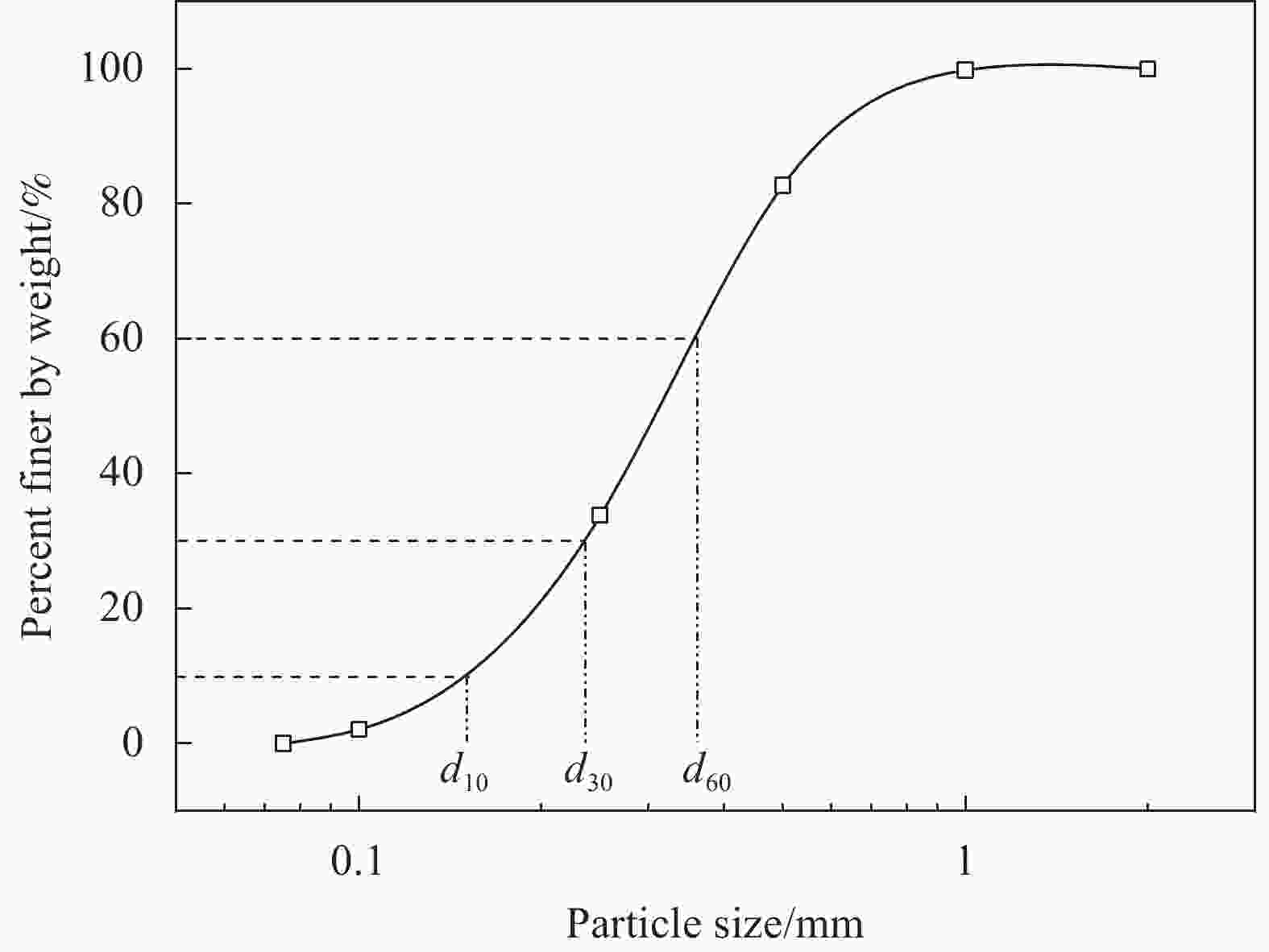
 下载:
下载:

